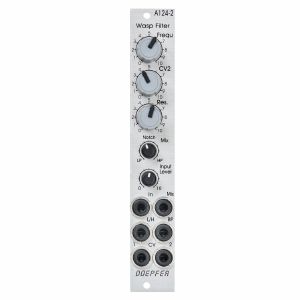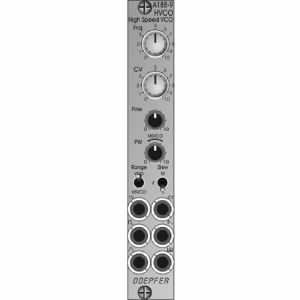Filter
Stock
Equipment
Format
Brand
Featured
Price
Tags
Back catalogue: All genres
Juno's full catalogue of All genresDoepfer A-124-2 Wasp Filter Module (silver, slim line) (filter synth module)
Cat: 1021093 Rel: 06 Sep 24
Wasp filter module - 4HP
Notes: Module A-124-2 is a special 12dB multimode filter using the "strange" filter circuit of the "EDP Wasp" (an analog synthesizer with black/yellow case built end of the seventies, manufactured by the UK company "Electronic Dream Plant").
The A-124-2 is the Slim Line version, which is only 4hp wide.
This design "abuses" digital inverters as analog operational amplifiers leading to distortions and other "dirty" effects that generate the specific sound of this filter. The filter is equipped with a band pass output and a combined low/notch/high pass output. For this output a control knob defines the relation between low and high pass signal. If both signals appear at the same level (i.e. middle position of the Mix knob) one obtains a notch filter. Otherwise the low or high pass signal predominates. The module does not feature self oscillation in contrast to most of the other filters of the A-100 system.
Dimensions:
4 HP
20 mm deep
… Read moreThe A-124-2 is the Slim Line version, which is only 4hp wide.
This design "abuses" digital inverters as analog operational amplifiers leading to distortions and other "dirty" effects that generate the specific sound of this filter. The filter is equipped with a band pass output and a combined low/notch/high pass output. For this output a control knob defines the relation between low and high pass signal. If both signals appear at the same level (i.e. middle position of the Mix knob) one obtains a notch filter. Otherwise the low or high pass signal predominates. The module does not feature self oscillation in contrast to most of the other filters of the A-100 system.
Dimensions:
4 HP
20 mm deep
1 in stock $122.96
Click for better price!
or call +44 20 7424 1960
quote 1021093
quote 1021093
Doepfer A-130-4 Quad VCA Module (vintage edition) (modular synthesiser)
Cat: 1021146 Rel: 05 Jul 24
Quad voltage controlled amplifier module - 4HP
Notes: Module A-130-4 contains four linear VCAs with a common level control section for all four VCAs. It can be used for all applications of simultaneous amplitude/level control of up to four different audio or CV signals. A-130-4 is the replacement of the no longer available module A-132-2. Compared to the A-132-2 the width has been reduced from 8HP to 4HP.
The module has these controls and in/outputs available:
Control Man.: manual control of the amplification
Control CV: attenuator for the control voltage applied to socket CVo socket Input 1
Sockets In 1...4: VCA inputs 1...4
Sockets Out 1...4: VCA outputs 1...4
Application examples:
simultaneous amplitude/level control of up to four different audio or CV signals
polyphonic application 1: simultaneous control of the frequency modulation depth of 4 VCOs (Quad-LFO A-145-4 or Quad-VCLFO A-147-5 > A-130-4 > FM inputs A-111-4)
polyphonic application 2: simultaneous control of the pulsewidth modulation depth of 4 VCOs (Quad-LFO A-145-4 or Quad-VCLFO A-147-5 > A-130-4 > PWM inputs A-111-4)
simultaneous control of quadrophonic signals
Technical notes:
The maximum amplification for each VCA is about 1 ("Man." control fully CW). Even with an external control voltage applied to the CV input the maximum amplification is limited to 1.
The module is equipped with two internal connectors (pin headers with 4 pins each). Pin header #1 can be used to normalize the four inputs to other modules (e.g. Quad LFO A-145-4 or A-147-5, Quad ADSR A-143-2). Pin header #2 can be used to connect the four outputs to other modules.
The max. level at the VCA inputs without clipping/distortion is about 20Vpp or +/-10V.
Width: 4 HP / 20.0 mm
Depth: 45 mm (measured from the rear side of the front panel)
Current: +30 mA (+12V) / -30 mA (-12V)
… Read moreThe module has these controls and in/outputs available:
Control Man.: manual control of the amplification
Control CV: attenuator for the control voltage applied to socket CVo socket Input 1
Sockets In 1...4: VCA inputs 1...4
Sockets Out 1...4: VCA outputs 1...4
Application examples:
simultaneous amplitude/level control of up to four different audio or CV signals
polyphonic application 1: simultaneous control of the frequency modulation depth of 4 VCOs (Quad-LFO A-145-4 or Quad-VCLFO A-147-5 > A-130-4 > FM inputs A-111-4)
polyphonic application 2: simultaneous control of the pulsewidth modulation depth of 4 VCOs (Quad-LFO A-145-4 or Quad-VCLFO A-147-5 > A-130-4 > PWM inputs A-111-4)
simultaneous control of quadrophonic signals
Technical notes:
The maximum amplification for each VCA is about 1 ("Man." control fully CW). Even with an external control voltage applied to the CV input the maximum amplification is limited to 1.
The module is equipped with two internal connectors (pin headers with 4 pins each). Pin header #1 can be used to normalize the four inputs to other modules (e.g. Quad LFO A-145-4 or A-147-5, Quad ADSR A-143-2). Pin header #2 can be used to connect the four outputs to other modules.
The max. level at the VCA inputs without clipping/distortion is about 20Vpp or +/-10V.
Width: 4 HP / 20.0 mm
Depth: 45 mm (measured from the rear side of the front panel)
Current: +30 mA (+12V) / -30 mA (-12V)
1 in stock $105.08
Click for better price!
or call +44 20 7424 1960
quote 1021146
quote 1021146
Doepfer A-188-9 HVCO High-Speed VCO Module (oscillator synth module)
Cat: 1046640 Rel: 12 Feb 25
High-speed voltage controlled oscillator module - 4HP
Notes: Module A-188-9 is a so-called high speed VCO that tracks perfectly to the 1V/oct scale in the frequency range of about 15kHz ... 500 kHz. The main application is the exact drive of BBD modules (A-188-1/2) to generate sounds realized by means of the so-called Karplus-Strong synthesis. But even in cooperation with other modules featuring high speed inputs (e.g. digital noise, delay, frequency divider) the A-188-9 makes sense. In principle the module is made of a precision audio VCO followed by a PLL (phase locked loop) unit that multiplies the frequency of the audio VCO by 32. Thus the module can be used also as an audio VCO as it features the standard waveforms sawtooth, triangle and rectangle with adjustable pulse width.
Controls:
Frq: frequency control (coarse)
CV: attenuator for the frequency control input CV
Fine: frequency control (fine), small control without knob
PW: pulsewidth control for the rectangle output of the audio VCO, in HSVCO mode this control has to be in the range marked "HSVO", small control without knob
Sockets:
1V: frequency control input 1V/oct scale
CV: frequency control input with attenuator CV
socket with rectangle symbol: rectangle output of the audio VCO, the pulse width of this output is adjusted by means of the control PW, output level ~ 7Vpp (~ -3.5V/+3.5V)
socket with sawtooth symbol: sawtooth output of the audio VCO, output level ~ 7Vpp (~ -3.5V ... +3.5V)
socket with triangle symbol: triangle output of the audio VCO, output level ~ 7Vpp (~ -3.5V ... +3.5V)
socket with inverted comb symbol: high speed VCO output, waveform rectangle, output level ~ 5Vpp (~ -2.5V/+2.5V)
Switches:
Range
upper position: audio VCO mode (frequency range of the audio VCO about 15 Hz to 6 kHz, the high speed output is not usable in this mode! )
lower position: High Speed VCO mode (frequency range of the high-speed output about 15 kHz ... 500 kHz, frequency range of the audio VCO about 500 Hz ... 15 kHz), in this mode the audio VCO and the high speed VCO can be used simultaneously
Slew
upper position: medium slew time
centre position: short slew time
lower position: long slew time
Technical Note regarding the Slew parameter:
Besides the audio VCO the module contains a so-called PLL circuit (Phase Locked Loop) and a 1:32 frequency divider. A slew limiter is part of the PLL. It defines how fast the frequency of the PLL follows the frequency of the VCO. The PLL cannot follow the VCO without any delay. Rather one has to find a compromise between the residual ripple of the PLL frequency and the frequency follow rate. That is the job of the slew limiter (works in principle like a glide or portamento unit). For this the module is equipped with a 3-position switch that is used to switch the slew time in 3 ranges. When mostly higher frequencies are used ((~ 100kHz ... 500 kHz) a short slew time can be chosen. When also lower frequencies are required (< 100kHz) a longer slew time may be used to reduce the residual frequency ripple. More details about the working principle of a PLL can be found in the information about module A-196. Module A-188-9 is in principle an A-196 combined with an audio VCO and a 1:32 frequency divider.
Width: 4HP / 20.0 mm
Depth: 45 mm (measured from the rear side of the front panel)
Current: +30 mA (+12V) / -15 mA (-12V)
… Read moreControls:
Frq: frequency control (coarse)
CV: attenuator for the frequency control input CV
Fine: frequency control (fine), small control without knob
PW: pulsewidth control for the rectangle output of the audio VCO, in HSVCO mode this control has to be in the range marked "HSVO", small control without knob
Sockets:
1V: frequency control input 1V/oct scale
CV: frequency control input with attenuator CV
socket with rectangle symbol: rectangle output of the audio VCO, the pulse width of this output is adjusted by means of the control PW, output level ~ 7Vpp (~ -3.5V/+3.5V)
socket with sawtooth symbol: sawtooth output of the audio VCO, output level ~ 7Vpp (~ -3.5V ... +3.5V)
socket with triangle symbol: triangle output of the audio VCO, output level ~ 7Vpp (~ -3.5V ... +3.5V)
socket with inverted comb symbol: high speed VCO output, waveform rectangle, output level ~ 5Vpp (~ -2.5V/+2.5V)
Switches:
Range
upper position: audio VCO mode (frequency range of the audio VCO about 15 Hz to 6 kHz, the high speed output is not usable in this mode! )
lower position: High Speed VCO mode (frequency range of the high-speed output about 15 kHz ... 500 kHz, frequency range of the audio VCO about 500 Hz ... 15 kHz), in this mode the audio VCO and the high speed VCO can be used simultaneously
Slew
upper position: medium slew time
centre position: short slew time
lower position: long slew time
Technical Note regarding the Slew parameter:
Besides the audio VCO the module contains a so-called PLL circuit (Phase Locked Loop) and a 1:32 frequency divider. A slew limiter is part of the PLL. It defines how fast the frequency of the PLL follows the frequency of the VCO. The PLL cannot follow the VCO without any delay. Rather one has to find a compromise between the residual ripple of the PLL frequency and the frequency follow rate. That is the job of the slew limiter (works in principle like a glide or portamento unit). For this the module is equipped with a 3-position switch that is used to switch the slew time in 3 ranges. When mostly higher frequencies are used ((~ 100kHz ... 500 kHz) a short slew time can be chosen. When also lower frequencies are required (< 100kHz) a longer slew time may be used to reduce the residual frequency ripple. More details about the working principle of a PLL can be found in the information about module A-196. Module A-188-9 is in principle an A-196 combined with an audio VCO and a 1:32 frequency divider.
Width: 4HP / 20.0 mm
Depth: 45 mm (measured from the rear side of the front panel)
Current: +30 mA (+12V) / -15 mA (-12V)
2 in stock $143.08
Click for better price!
or call +44 20 7424 1960
quote 1046640
quote 1046640
Doepfer A-192-2 Dual CV & Gate To MIDI & USB Interface Module (B-STOCK) (CV to MIDI synth module)
Cat: 1089637 Rel: 01 Jan 90
B-STOCK: Slight surface marks
Notes: ***B-STOCK: Slight surface marks ***
Module A-192-2 contains two independent CV/Gate-to-Midi/USB interfaces. For each of the two sub-units these inputs are available:
- Gate Input (min. +5V)
- CVN Input (defines the Midi note number), 1V/octave standard, range 0...+10V (i.e. 10 octaves)
- CVV Input (defines the velocity value assigned to the Midi note message), can be used alternatively for Midi volume (CC#7), range 0...+5V
- CVC Input (free assignable to any Midi control change number), range 0...+5V
For both sub-units a common CV Transpose input is available (1V/octave, range 0...+10V). The voltage applied to this input is added internally to CVN before the Midi note number is generated. It can be used e.g. to transpose two sequences simultaneously by one voltage.
How it works:
Whenever the rising edge of the Gate input is recognized a Midi note on message is generated. The note number corresponds to the sum of the voltages applied to the CVN input and the common CV Transpose Input that is present at the rising edge of the gate signal.
… Read moreModule A-192-2 contains two independent CV/Gate-to-Midi/USB interfaces. For each of the two sub-units these inputs are available:
- Gate Input (min. +5V)
- CVN Input (defines the Midi note number), 1V/octave standard, range 0...+10V (i.e. 10 octaves)
- CVV Input (defines the velocity value assigned to the Midi note message), can be used alternatively for Midi volume (CC#7), range 0...+5V
- CVC Input (free assignable to any Midi control change number), range 0...+5V
For both sub-units a common CV Transpose input is available (1V/octave, range 0...+10V). The voltage applied to this input is added internally to CVN before the Midi note number is generated. It can be used e.g. to transpose two sequences simultaneously by one voltage.
How it works:
Whenever the rising edge of the Gate input is recognized a Midi note on message is generated. The note number corresponds to the sum of the voltages applied to the CVN input and the common CV Transpose Input that is present at the rising edge of the gate signal.
1 in stock $130.78

 USD
USD









